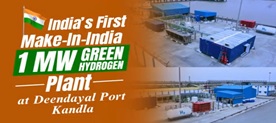08 December, 2025
India’s First Make-in-India Green Hydrogen Plant
Wed 06 Aug, 2025
Context:
The Deendayal Port Authority (DPA), located in Kandla, has commissioned India’s first "Make-in-India" green hydrogen plant.
Project Overview:
- Location: Deendayal Port, Kandla, Gujarat
- Capacity: 1 MW (part of a planned 10 MW expansion)
- Inauguration Date: 30 July 2025
- Key Feature: Fully indigenously developed technology using India-made electrolyzers
- Production Capacity: ~140 metric tons of green hydrogen per year
- Execution Time: Completed in just 4 months
- Key Contributors: Deendayal Port Authority (DPA) and Larsen & Toubro (L&T)
This plant is India’s first port-based green hydrogen project, utilizing indigenous engineering and technology under the Make-in-India initiative.
Green Hydrogen Production:
- Green hydrogen is produced through electrolysis of water, using electricity from renewable energy sources like solar and wind.
- Electrolyzers split water into hydrogen and oxygen without any carbon emissions.
- The electrolyzers used at Kandla plant are manufactured at L&T’s Hazira plant in Gujarat.
Scalability:
- The current 1 MW plant is a part of a larger 10 MW project, whose foundation stone was laid by Prime Minister Narendra Modi on 26 May 2025 in Kutch.
Environmental Impact:
Net-Zero Vision:
- Supports India’s goal of Net-Zero carbon emissions by 2070.
- Green hydrogen is a clean fuel and a sustainable alternative to fossil fuels.
- Promotes decarbonization of the maritime sector, especially port operations traditionally reliant on diesel.
Sustainability:
- The annual production of 140 MT of green hydrogen contributes to eco-friendly port operations.
- The project aligns with the Maritime India Vision 2030 and its Green Port Guidelines, pushing Indian ports toward sustainability.
Green Hydrogen:
- A clean and sustainable energy source, green hydrogen is produced by splitting water (H₂O) into hydrogen and oxygen using a process called electrolysis, powered by renewable energy such as solar and wind.
Main Objectives:
- Use as a clean energy source
- Reduce carbon emissions
- Reduce dependence on energy imports
- Provide green alternatives in industry, transport, fertilizer, and steel sectors
Other Types of Hydrogen:
| Type | Description |
| Grey Hydrogen | Produced from natural gas (methane); high carbon emissions |
| Blue Hydrogen | Like grey hydrogen, but emissions are reduced using Carbon Capture & Storage (CCS) |
| Green Hydrogen | Fully based on renewable energy with zero emissions |
India’s Initiative: National Green Hydrogen Mission
- Announced: 15 August 2021
- Launched: January 2023
Mission Targets:
- Produce 5 million metric tons of green hydrogen by 2030
- Total budget: ₹19,744 crore
- Make India a global green hydrogen hub
- Promote both domestic use and exports
Make in India – Key Facts
- Launch Date: 25 September 2014
- Launched by: Prime Minister Narendra Modi
- Nodal Ministry: Ministry of Commerce and Industry
Objectives:
- Promote manufacturing and investment in India
- Create employment and encourage skill development
- Make India a global manufacturing destination
- Boost exports and attract FDI
Key Sectors (25 focus sectors):
Automobile, Aviation, Defence Manufacturing, Electronics, Renewable Energy, Pharmaceuticals, IT, Railways, Textiles & Apparel, Chemicals & Fertilizers, etc.
Achievements:
- FDI Growth: India attracted over $70 billion FDI in 2023–24
- Rise in domestic manufacturing: smartphones, defense, and renewable energy equipment
- Global brands like Apple, Samsung, Tesla expanded manufacturing in India
- Defence growth: Production & export of Tejas aircraft, INS Vikrant
- Boost in renewable energy: Local production of solar/wind equipment, e.g., Kandla Green Hydrogen Plant
Aatmanirbhar Bharat :
- Announced on: 12 May 2020
- By: PM Narendra Modi
- Background: In response to COVID-19 and global supply chain disruptions
Key Goals:
- Make India self-reliant and confident
- Strengthen local production and supply chains
- Boost exports and reduce import dependency
- Encourage innovation, startups & technology
- Accelerate employment and rural-urban development
Five Pillars of Aatmanirbhar Bharat:
- Economy – Growth-centric
- Infrastructure – Foundation for future
- Technology-driven System
- Demography – India’s strength
- Demand – Boost domestic consumption
Focus Sectors:
- Industry & Manufacturing (Make in India)
- Agriculture Reforms
- Health & Pharmaceuticals
- MSMEs
- Digital India & Startups
- Defence, Space, and Energy


















